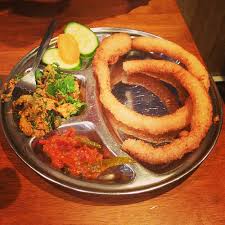Boudha is the melting pot of everything that has come to represent Kathmandu – religion, culture, chaos and good food. Multi-colored prayer flags flutter from the buildings, guttural chants waft the air and the peace that suddenly envelops as you wander the bustling streets is almost surreal. Stray from the main thoroughfare and you will suddenly end up in an intricate network of gallis, and it is in these hidden alleyways that you will find delicious servings of the relatively unknown lhaphing.
Try Lhaphing for three main reasons. First for its origins. Lhaphing was originally a Sichuan cuisine called liang fen, that is universally enjoyed as delicious street food across the Tibetan plateau. Secondly for its culture. This Tibetan dish has travelled via northern Nepal with the many Tibetan émigrés who have made Boudha their home. Here, the taste has been kept alive by the migrants and now the cuisine is finally catching on with Kathmandu locals as well. Third and most importantly, try lhaphing for its scrumptious taste. A cold summer dish, extenuated by spices, this culinary delight is bound to twist your palate. All in a good way.
So what is lhaphing like? Lhaphing is a noodle dish seasoned with spices. The noodle is made from starches extracted either from potato or flour, and is cooked overnight. Once the extract has settled, they are cut and formed into noodles before being dipped in a sauce made from dried chilies and vinegar. A variety of spices including garlic, cloves, onions and coriander is thrown in to add to its flavor profile, along with a healthy dose of sesame oil.
This cold dish takes your taste buds by storm, and is a culinary experience that you will not find anywhere else in the valley. Couple that with the rich history and culture behind the food, and it makes a mandatory Kathmandu experience.
The taste aside, lhaphing also makes for a delicious social food. It is light and spicy and you don’t necessarily need an empty stomach to enjoy the dish. It is easy to prepare (thus quickly served) and easier to devour over gossiping and merry making with good company. On your next escapade to Boudha, make sure you hunt down a good lhaphing pasal. I bet it won’t be too difficult!
This cool and spicy dish, especially refreshing in summer, comes to us from the kitchen of our dear friend and excellent cook, Dolkar. A cold jelly noodle dish — originally called liang fen in Sichuan cuisine — laping would not traditionally be made at home. Most people in Lhasa, for example, would buy it from little stalls on the street. Tibetans outside Tibet do make this at home, as there are no laping stalls on most of our city streets!
For 6-8 people
Note: The laping requires at least 4-5 hours to set, and can be prepared the night before and left to set overnight.
Ingredients for the Laping
- 1 cup of potato or mung-bean starch (For the images here we used potato starch, but we’ve also made it with mung bean starch, and those noodles turn out much stiffer, which you may like, as a matter of personal taste. Mung-bean starch can be found in Korean stores and some other Asian markets.)
- 5 cups of water
Ingredients for the Sauce
- 7 cloves of garlic, minced
- 1 stalk green onion, chopped
- ¼ cup cilantro, chopped
- 1 teaspoon salt
- 1 teaspoon rice vinegar
- ¼ cup sesame oil
- ¼ cup soy sauce
- ¼ cup crushed dried red pepper (We bought this at an Asian store. If you can’t find this, you can cut up dried red pepper, or use chili powder, or a bit of chili sauce. )
Preparing the Clear Noodles
Before heating, stir the starch and water together until you get an even texture.
Heat the mixture on stove top to medium, stirring frequently, for 8-9 minutes, or until the mixture is so thick you can barely stir it. If the mixture is boiling before it thickens, turn down the heat until it stops boiling. When done the texture will be very thick, almost like jello, but it still needs to set.
Transfer the cooked mixture into a clean bowl and let it sit overnight at room temperature. In order to shorten the time for cooling, it can also be placed in the refrigerator for 4-5 hours.
After the laping has set, remove it from the bowl. It should stand up by itself, like a very firm jello.
In Tibet, people grate the laping with a very large grater, but our grater was too small and didn’t really work, so we did what many Tibetans do, and just cut the laping with a large knife into long strips.
Prepare the Sauce and Combine with Noodles
- Mince 7 cloves of garlic
- Chop 1 stalk green onion
- Chop ¼ cup cilantro
- Combine garlic, onion and cilantro with 1 teaspoon salt, 1 teaspoon rice vinegar, ¼ cup sesame oil, ¼ cup soy sauce, and ¼ cup crushed dried red pepper in a small bowl and stir well. This amount of pepper makes it VERY spicy. If you’re not accustomed to spicy food, just add the pepper in very small increments until you hit the right amount for you.)
- Drizzle the sauce over the laping, then mix gently with a spatula or other flat utensil until the laping is well-coated with the sauce.
Serve as a side dish with any meat or veggie entree, or as a tasty snack on its own.
Note:
- Strips of cucumber make a fresh, crunchy addition.
- Some readers have reported success also with using corn starch and potato starch if you don’t have mung bean starch.

























